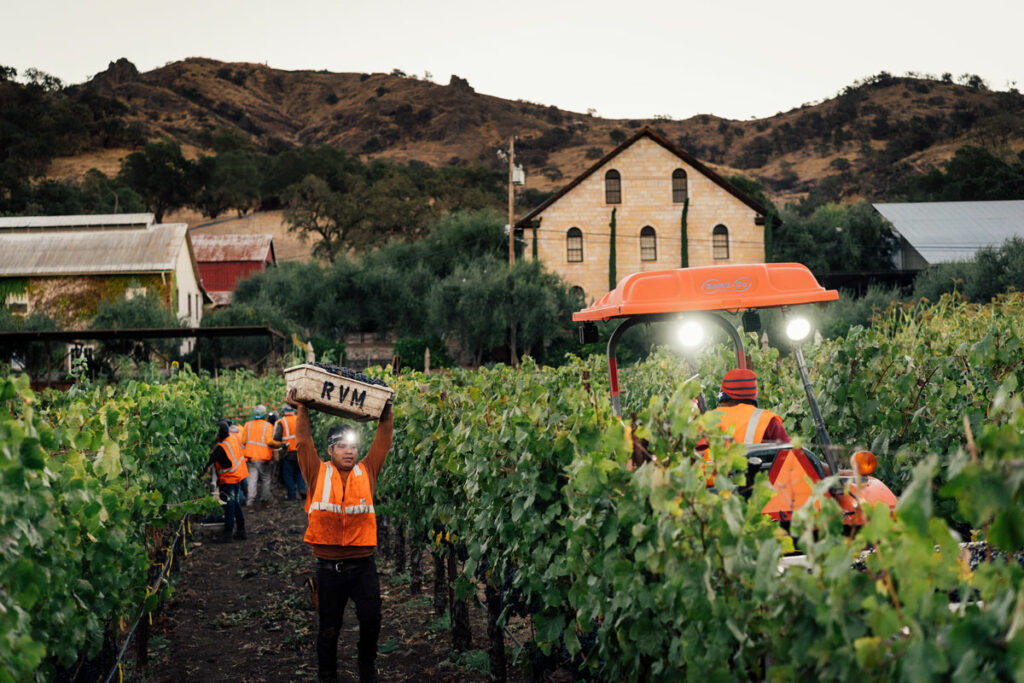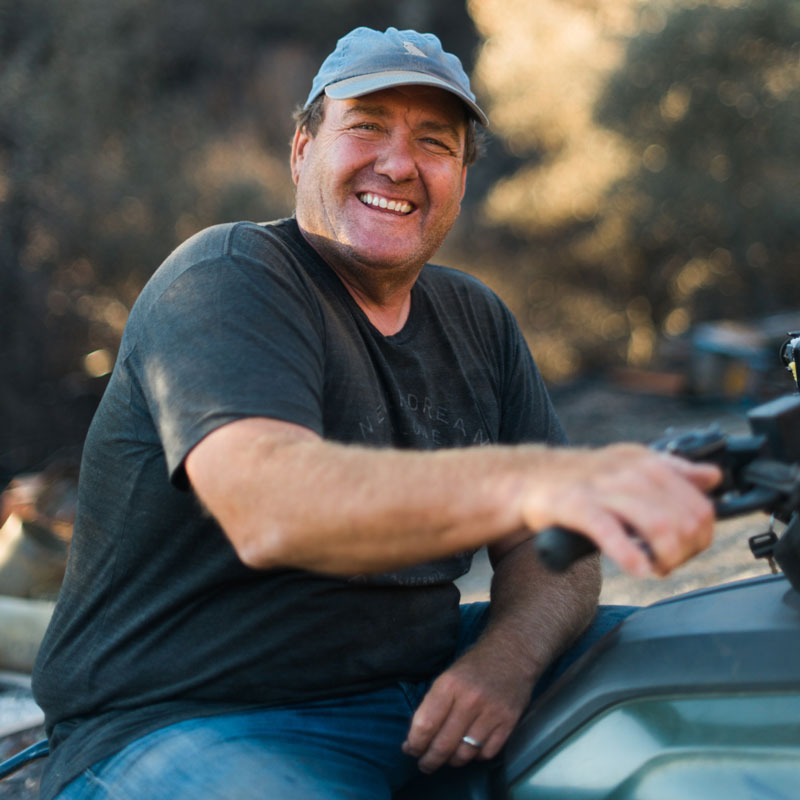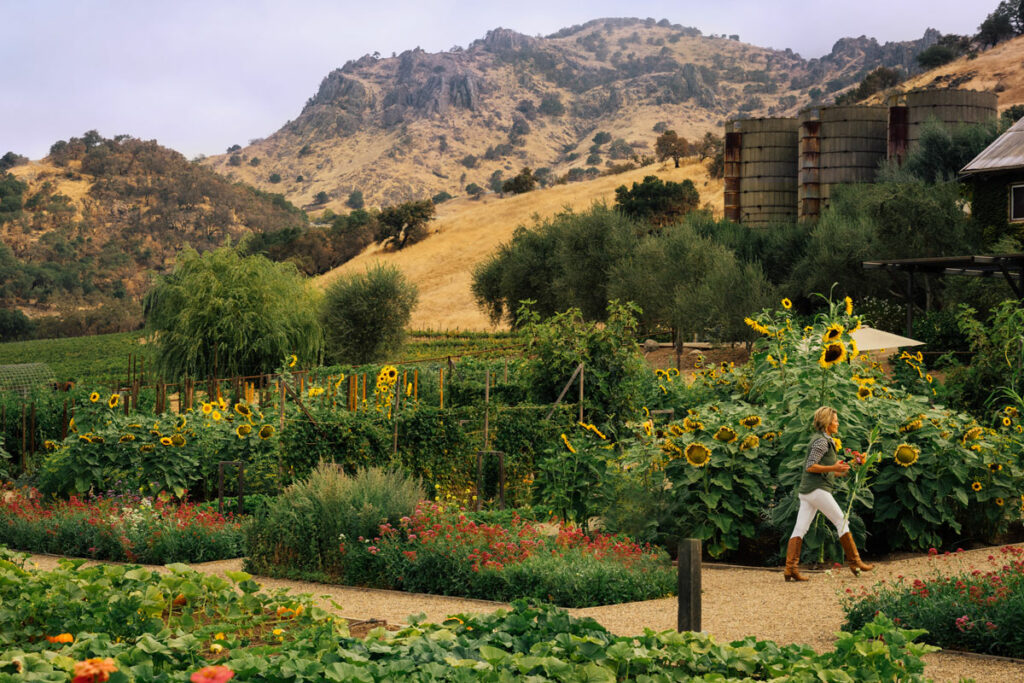We’re farmers first
The highest and best use of this land has always been agriculture.

Today, a visit to Regusci Ranch centers around a glass of wine, made from Bordeaux varietals first planted on the ranch in the late 1960s by Jim’s dad, Angelo. But the truth is, we’ve farmed a literal cornucopia of goods on this land since we took it over in 1932. As farmers we evolved to sustain our livelihood.
Gaetano Regusci began with a dairy, and eventually added a fleet of milk delivery vehicles. He also farmed corn, hay, walnuts, and a small block of grapes for home winemaking. He and his wife, Livia, raised their son Angelo and daughter Isabelle, on the ranch, and like most farming families when the time came, his son took the reins. In the 1950s Angelo Regusci shifted to livestock and butchery, adding a trio of silos, a hay barn, and a slaughterhouse. His sister Isabelle and her husband Amador Simone worked their entire lives living and farming on the Regusci property. There are still people in the Valley who can remember pulling right up to Isabelle’s kitchen window and honking the car horn. She’d throw open the window, take their meat order and then invite them in for hot coffee and fresh baked cookies at her kitchen table.

You name it, we probably have harvested and sold it at some point.


Luckily the Ranch sits in an exceptional spot in Stags Leap, with the ideal climate and terroir for growing, so the family kept current with whatever crops were in fashion and held on. The diversity in soils is a viticulture dream, varying from volcanic (from past eruptions) to clay-loam from the nearby Napa River, and gravely hillsides. Originally on the ranch were the old Zinfandel vines originally planted by TL Grigsby. At the time, neighboring Chimney Rock Winery was a golf course. There were only 600 acres of Cabernet Sauvignon wine grapes planted in the entire state of California at the start of the 1960s. But by 1970, neighbor Nathan Fay was experimenting with planting Bordeaux varietals and as the decade progressed the region was beginning to capture some attention in winemaking circles. The literal roots of new world wine were taking hold in the Valley and the Regusci family was in a fortuitous position and ideal location, they just didn’t know it.
In 1970 Angelo struck a deal with John Goelete, agreeing to a long-term lease on 120 acres on the West side of the ranch for the purpose of growing grapes for a new winery to be named Clos du Val. Nathan Fay, Warren Winiarski and Angelo Regusci were pretty much the only people in the area planting Bordeaux varietals when Jim, Angelo’s youngest son, turned nine. It was 1976 and Stag’s Leap Wine Cellars Cabernet Sauvignon had just won the Judgement of Paris.

Having spent his entire life on the ranch, Angelo knew how difficult the life of a farmer could be.
The Napa Valley had officially earned its place as a world class winegrowing region, and Angelo did what any good farmer would do. He agreed to lease the old dairy parcel (120 acres across the road from the homestead) to Robert Mondavi Winery and began the chain of events that ushered in a new era on the Ranch. It was fortuitous timing for Angelo’s youngest son. Jim came of age in the late 80s, and in 1986 he launched Regusci Vineyard Management shortly after graduating high school. “The way I see it,” says Jim, “We ranched and farmed what we needed to get by, feed our family and make a little money. With Gaetano it was milk and prunes. For my dad it was butchery and eventually vineyards. I knew reviving our own wine production would allow us to not just survive, but thrive. For me it was a classic case of right place, right time. As the neighborhood has advanced, so have we.”
In his 20’s, Jim launched a vineyard management company to farm vineyards all over the Napa Valley and beyond.


Although it was Jim’s dad who put the first contracts into place and planted the first Cabernet on the ranch, it was Jim who solidified the family’s future on the land by reviving the winery. Even though they were farming nearly 200 acres of vines in 1996, all the fruit was contracted out. It was Dan Duckhorn who made it possible for Jim to realize his vision when he agreed to give back every other row of Duckhorn’s contracted fruit. Well before consulting winemakers were en vogue, Jimmy asked winemaker Charles Hendricks for assistance, and under his watchful eye Jim and Angelo bottled the first vintage of Regusci Winery Estate Cabernet Sauvignon, Merlot, and Zinfandel, with borrowed equipment inside the old distillery on the property using Angelo’s home winemaking equipment. The experiment would prove to be a pivotal moment for the Ranch.
Today, this historic family property is a prosperous working ranch. There are 170 acres of vines under cultivation, with 50 acres reserved exclusively for Regusci Winery. Alicia, Jim’s daughter, and her husband Matt Hardin continue the tradition of farming by making their own wines, Caterwaul and Matthew Wallace, with fruit from two family blocks. The slaughterhouse has been converted to offices, but Aunt Isabelle still feeds the ranch crew and an occasional neighbor at her kitchen table. The old distillery and hay barn have been converted and expanded into an inviting space where guests can taste through distinctive estate wines, many named in honor of family members. The old Occidental Winery has been lovingly restored to its original purpose, boasting three floors where past meets present, each floor ready for entertainment. What was once a well-worn ranch, is now spilling over with the most sought-after wine experiences in the Napa Valley.

These days the newest part of our farming operation is a 2-acre garden.


The longstanding tradition of livestock continues with pens of turkeys and chickens, sheep, goats, horses and cows. Jim’s wife, Laura, who comes with a rich agricultural background, inspired the diversification of the property by way of prolific organic gardens, flower beds and fruit orchards. Native species are being reintroduced to wild spaces, heritage trees are maintained and farming systems including waste water, livestock and land management have evolved to meet the highest standards of sustainability. The ranch boasts a year-round farm stand and in addition to providing food and beauty these thoughtfully cultivated spaces help to maintain biodiversity on the property and contribute to the long-term health of the land and the people who live, work and visit here.
The Regusci Ranch continues to evolve with the neighborhood. It’s rustic authenticity is reflected in the spirit of its farming practices and the nature of its hospitality. And, with a fourth generation of Reguscis already planning ahead and a fifth generation in the wings, our role remains to respect and honor the health and vitality of our land and ensure its prosperous for years to come.

